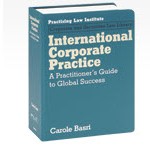Book Review: Fashion Law and Business: Brands & Retailers
BY: Andreea Alexander | February 14, 2014 at 10:56 AM
Lois F. Herzeca & Howard S. Hogan. 2013. Fashion Law and Business: Brands and Retailers. Practising Law Institute: New York. 847 pages. $185 from publisher; $145.48 from Amazon.com
While the subject hasn’t yet garnered the broad name recognition of practice areas like sports law and entertainment law, those familiar with the actual study and practice of fashion law understand that it’s about more than whether you should match your shoes to your belt (or even the Louboutin red soles case). Fashion law encompasses a broad range of issues such as corporate law, international trade, labor and employment, real estate, and of course intellectual property. And now, with Fashion Law and Business: Brands & Retailers, Lois F. Herzeca and Howard S. Hogan take fashion law a little further into the mainstream legal world.
If your library purchases only one book on fashion law, this should be it. Now, admittedly, there are only a handful of books explicitly dedicated to fashion law currently in print, so the options are fairly limited. But in my opinion, this book is by far the most helpful for students and practitioners alike. As one might deduce from the publisher, the Practising Law Institute, this text is targeted more toward practitioners, and was in fact written by two attorneys who Co-Chair their firm’s Fashion, Retail and Consumer Products Practice Group. The authors explain in the introduction, “[T]his book is structured on the presumption that fashion law can be best examined in the context of an understanding of the business and operations of the fashion industry.” This is not a casebook, and it’s not written to be a textbook (although it would be helpful in a fashion law course). It is the most comprehensive guide to fashion law that has been published so far, with 847 pages (more than twice the pages of the next longest text on fashion law), and accurately captures both the large and small issues of the subject.
Other in-depth examinations of fashion law feature chapters written by different scholars and practitioners on various topics; this leads to some redundancy as similar ideas are reiterated in different contexts. Fashion Law and Business benefits from a unified tone thanks to the treatment of each topic by the same two authors. The finding aids are excellent, including a detailed table of contents, a 36-page index, and a table of authorities allowing the reader to focus on specific cases or statutes. Cases are not reprinted but are discussed in some detail, and the authors wisely chose to incorporate not only overtly fashion law-oriented cases but also cases that do not involve fashion but are critical to understanding a given topic in fashion law; for example, the grey market is a major issue in fashion law, but a basic understanding of the grey market would be incomplete without John Wiley & Sons v. Kirtsaeng. Fashion Law and Business includes an explanation of that case alongside more clearly fashion-oriented cases like Abercrombie & Fitch v. Fashion Shops of Kentucky.
If I have one quibble with Fashion Law and Business, it’s that references are grouped at the end of each chapter as endnotes, instead of in footnotes on the relevant pages; flipping back and forth is a little bit bothersome for someone accustomed to the reference style of law reviews and journals. But this is a minor issue, and the benefits of this text far outweigh that small irritation. It’s also a comparatively good bargain—other fashion law texts are published in paperback and cost upwards of $80; at about $145 (prices via Amazon.com), this hardcover text delivers more content and promises to be more physically resilient.
I’ve followed the recent publication of fashion law books with great interest, and this is the first one I felt I could unreservedly recommend for the libraries of both law schools and law firms. It is thorough, well-written, and may help your library’s patrons see that “fashion law” means something more than “leggings aren’t pants!”
Andrea Alexander is a reference librarian and assistant professor at Ohio Northern University Pettit College of Law’s Taggart Law Library. She never wears leggings as pants.


